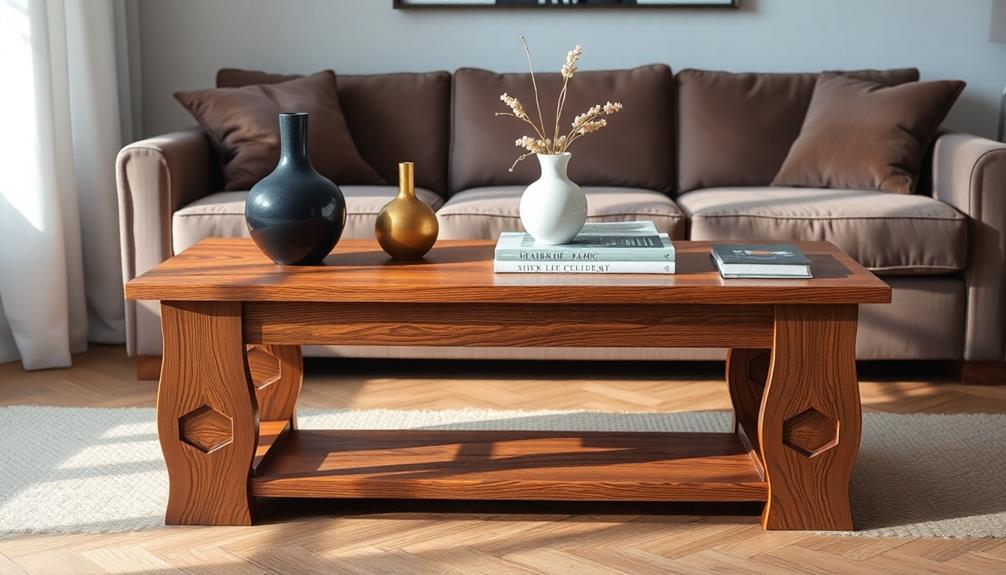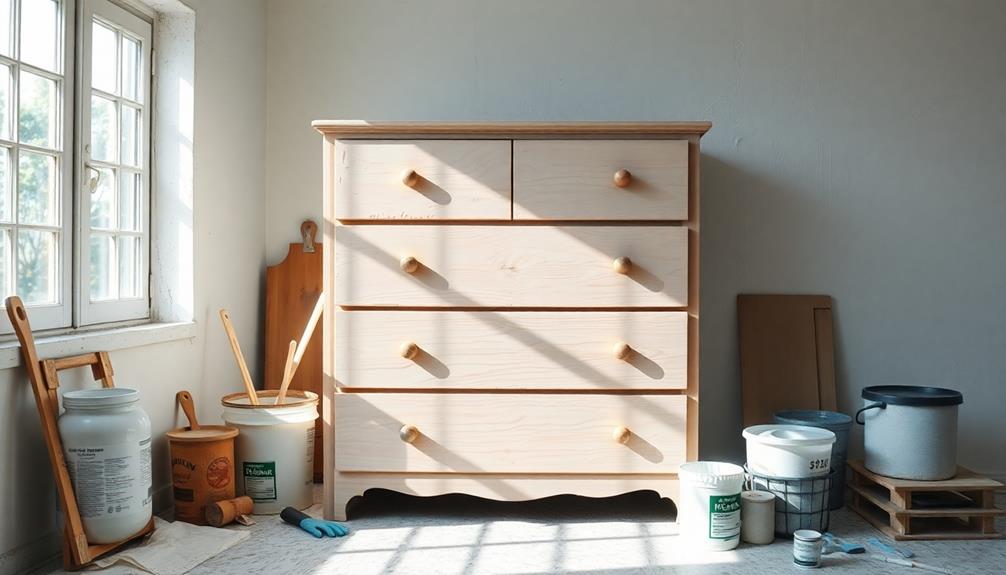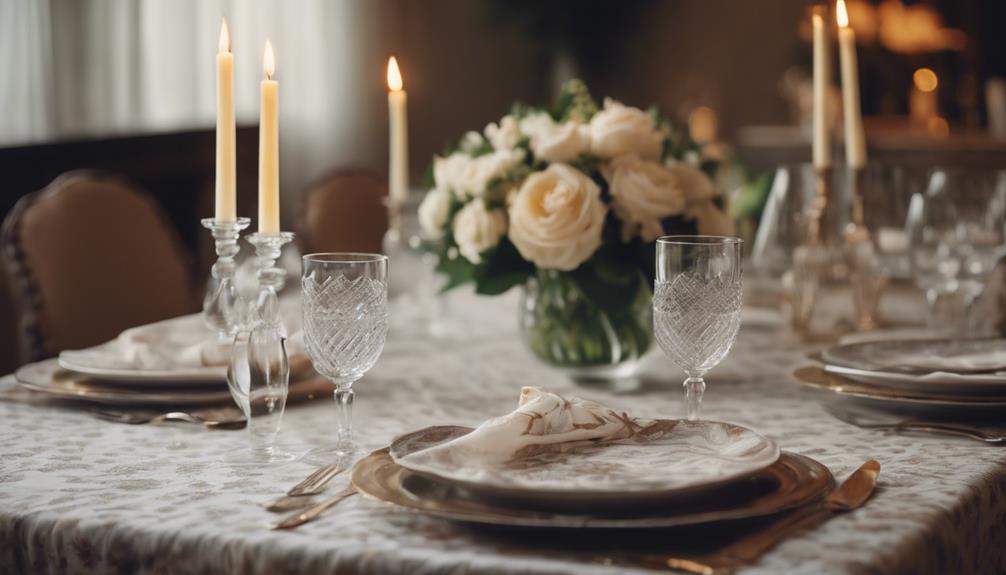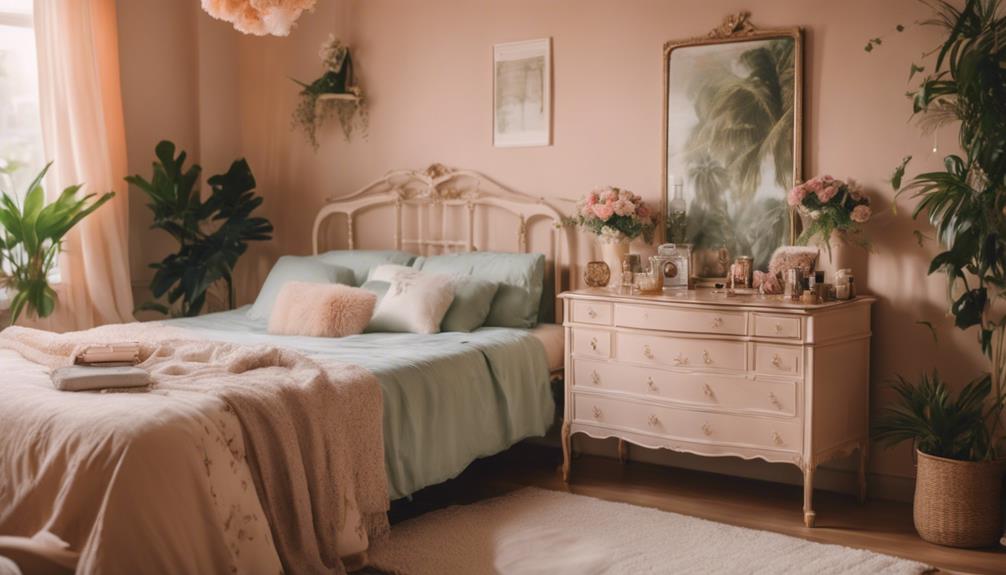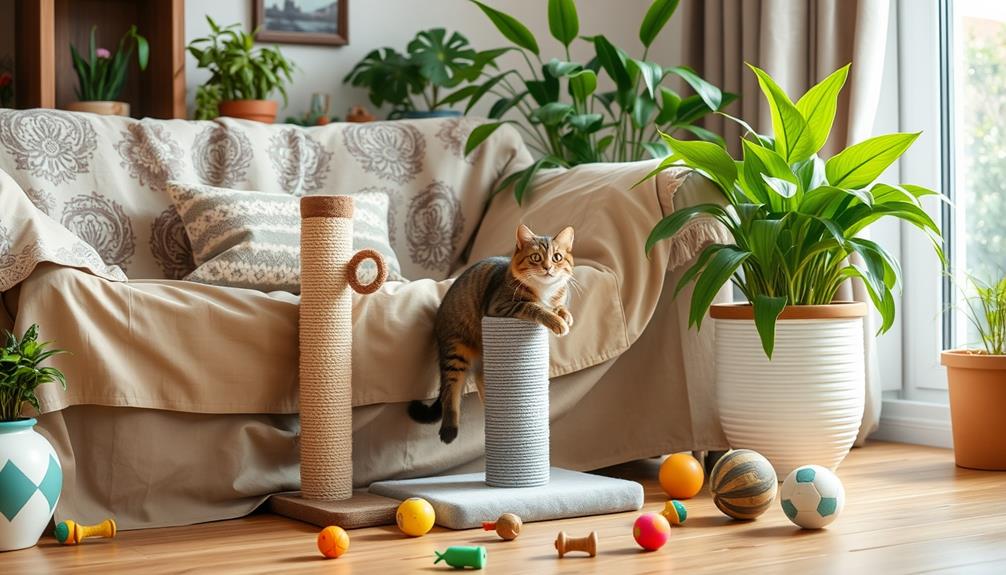Building a sofa table is a fulfilling project that can elevate the look of your living space. To start, gather materials such as 2x4s for the table legs and a 1×10 for the tabletop. You will also need a drill, miter saw, and sandpaper to ensure the table is sturdy. Measure your sofa, cut the wood accordingly, and then assemble the table using nails and brackets for added stability. Once assembled, sand the table and finish it off with a wood stain for a polished appearance. Place the table about 2-6 inches away from your sofa for easy access. These basic steps will help you create a chic and functional addition that complements your decor perfectly. Don’t forget to consider additional touches for the perfect final look!
Key Takeaways
- Gather essential materials, including lumber, hardware, and finishing supplies for a sturdy and visually appealing sofa table.
- Measure and cut lumber accurately to ensure the table complements the sofa's dimensions for a harmonious look.
- Assemble the table by securely connecting legs and the tabletop using nails, brackets, and ensuring all connections are flush.
- Sand surfaces and apply wood stain and protective finish for a polished look and durability.
- Position the table thoughtfully, maintaining clearances for accessibility and aligning with the overall room design for functionality.
Materials Needed
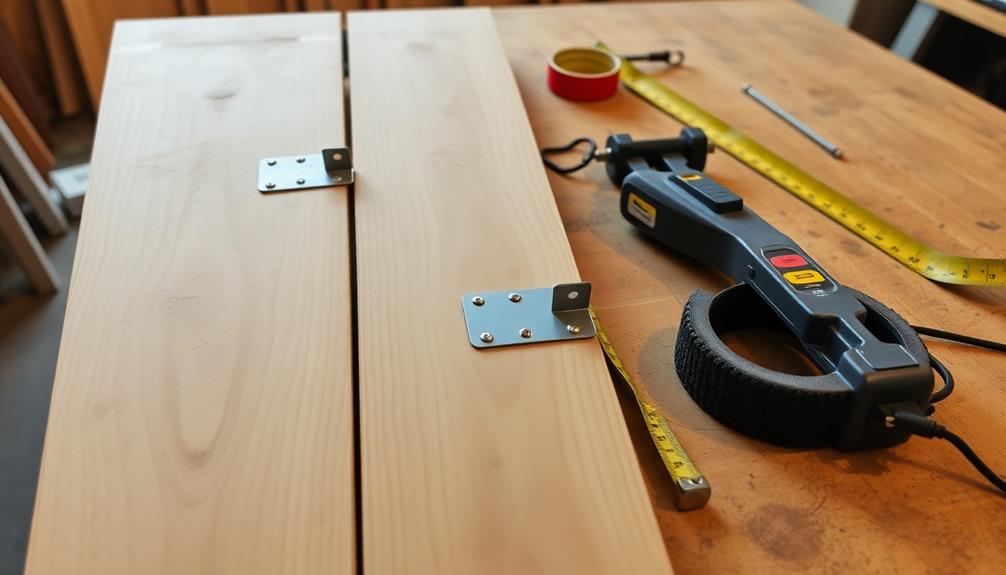
To build a basic sofa table, you'll need several key materials to guarantee its sturdiness and style. Start with four pieces of 2x4s for the legs, which will provide essential support. For the tabletop, a single piece of 1×10 wood will create a spacious surface perfect for displaying decor or holding drinks.
Incorporating innovative design solutions can also enhance the overall aesthetic and functionality of your sofa table. To enhance stability, include one piece of 1×4 as a support beam that connects the legs.
For added strength, consider using joint L brackets and mending plates to secure connections between the wood pieces. If you're aiming for a rustic aesthetic, reclaimed wood for the tabletop can bring character to your sofa table, making it a unique focal point in your living space.
Once you've selected your materials, think about a wood stain to finish your project. Shades like Dark Walnut can beautifully complement your existing decor and really elevate the overall look of the table.
Essential Tools
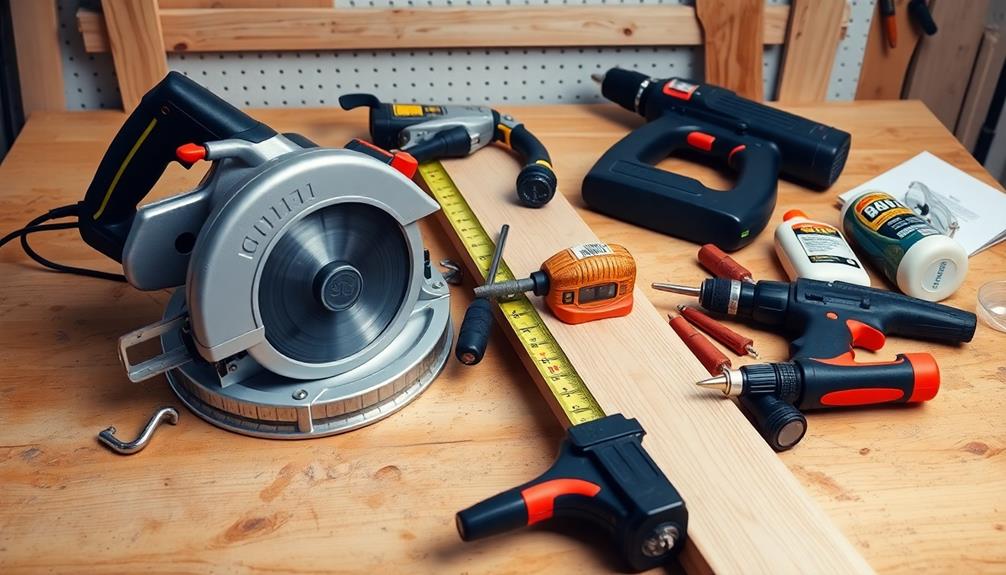
To build your sofa table effectively, you'll need some essential tools to guarantee accuracy and quality. Having the right tools not only improves the precision of your cuts but also enhances the overall user experience during the building process, which is vital for a successful project.
A miter saw, pocket hole jig, and drill are must-haves for precise cuts and strong joints. Additionally, you might want to take into account conducting regular audits on your tools to confirm they're in peak condition.
Optional tools like an oscillating tool can also enhance your build, making it easier to adapt to specific features in your space.
Must-Have Tools
When building a sofa table, having the right tools at your disposal is vital for a successful project. The following must-have tools will guarantee your build is efficient and precise:
Additionally, selecting quality tools can greatly impact the overall craftsmanship of your piece, especially when you consider the importance of best vacuum options for maintaining a clean workspace during and after your build.
- Drill: This is essential for creating pilot holes and driving screws, guaranteeing a sturdy assembly of your sofa table.
- Miter Saw: A miter saw allows for accurate angled and straight cuts on lumber, helping you achieve clean edges and precise dimensions.
- Pocket Hole Jig: Using a Kreg Jig simplifies the process of joining pieces with pocket holes, providing strong and hidden connections between components.
- Sandpaper or Electric Sander: You'll need this for smoothing surfaces and edges, which enhances the overall finish and safety of the table.
Optional Tool Benefits
Contemplating additional tools can enhance both the efficiency and quality of your sofa table project. A drill is an essential tool for creating pilot holes and driving screws, guaranteeing a sturdy assembly without splitting the wood.
It's particularly useful when working with hardwood, as using a pilot drill bit helps prevent damage while inserting screws. Additionally, utilizing energy-efficient appliances during home improvement projects can greatly reduce your overall energy consumption.
Incorporating a miter saw into your toolkit allows for precise angled cuts, which can elevate your table's design and aesthetics. This tool helps guarantee that your corners fit perfectly, giving your sofa table a professional look.
The Kreg Jig is another fantastic option to take into account. It facilitates pocket hole joinery, providing strong and clean connections between pieces without visible fasteners.
This not only improves the overall appearance of your table but also enhances its structural integrity.
Design Inspiration
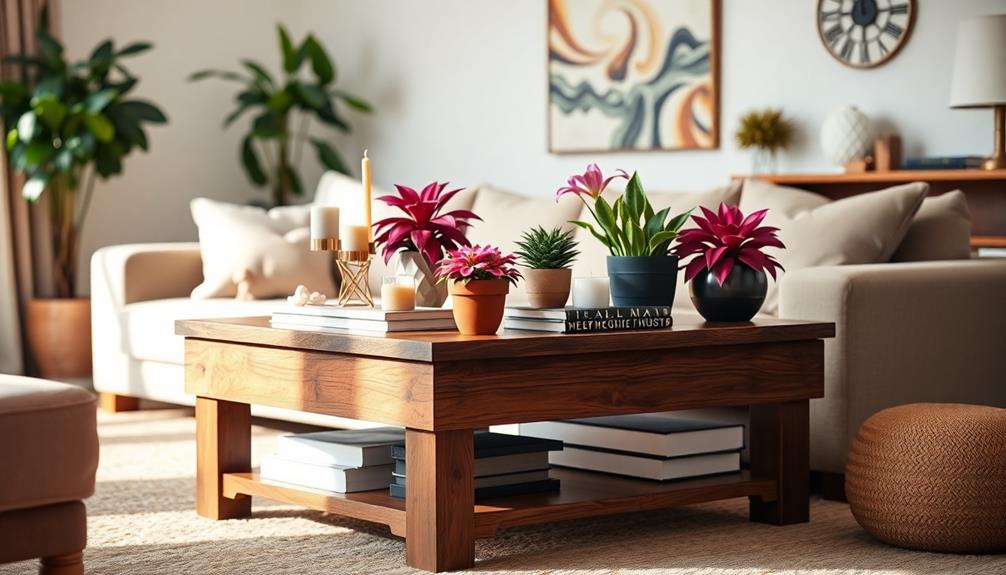
What elements are essential for creating a sofa table that reflects your style? When you're tackling a DIY sofa table project, it's vital to gather design inspiration that resonates with your aesthetic preferences. Consider these key aspects:
1. Dimensions: Measure your space carefully. Your table should complement the height and width of your sofa to guarantee a cohesive look. Additionally, ensure that the table’s length is proportionate to the seating area to allow easy access without overcrowding the space. When measuring a sofa correctly, take into account its total length, depth, and height, as these dimensions will significantly impact your choice of a table. A well-measured sofa ensures that the table fits seamlessly and enhances the overall balance of the room. Also, consider the space around the table to ensure adequate room for movement, especially if it’s placed in a high-traffic area. Measuring a sofa properly allows you to select a table that not only looks aesthetically pleasing but also maintains functionality in the space. By ensuring both furniture pieces are proportional, you achieve a harmonious and inviting living area.
Taking cues from mood boards essential can help visualize how the table will fit into your overall design.
2. Style: Explore various styles, such as modern, rustic, or industrial. This allows your sofa table to blend seamlessly with your existing decor.
Surprising insights often emerge during style discovery, so don't hesitate to experiment with different aesthetics.
3. Functionality: Think about incorporating features like storage compartments or built-in power outlets.
These additions enhance usability and cater to your lifestyle needs.
4. Materials: Opt for reclaimed wood or furring strips for a budget-friendly option.
This choice not only saves money but also promotes sustainability in your furniture builds.
Cutting Instructions
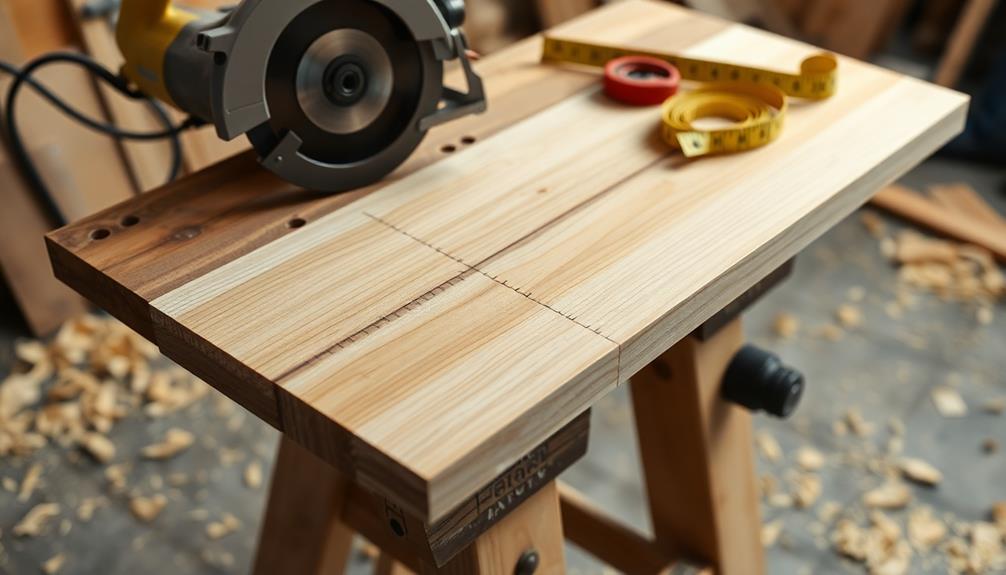
Getting your measurements right is vital for a successful sofa table. You'll need to make precise cuts to guarantee everything fits snugly and looks great.
To enhance your woodworking project, consider the benefits of an efficient heating solution in your workspace, such as a high-efficiency Englander 10-Cpm Corn Wood Pellet Stove for ideal warmth during colder months.
Let's go over the essential cutting techniques that will help you achieve a stable and stylish piece.
Accurate Measurements Importance
Accurate measurements are essential when building a sofa table, as they guarantee your piece fits perfectly behind the couch. Proper planning can also enhance your financial health, much like creating a budget guarantees your spending aligns with your income.
To achieve this, you need to take into account a few key factors that influence the dimensions of both the tabletop and the table legs.
- Measure your couch width: For ideal coverage, your tabletop should be about 2 inches longer than your couch width.
- Determine the sofa height: With a standard sofa height of 30 inches, cut your table legs to match this measurement, ensuring both functionality and aesthetic harmony.
- Check the back of your couch: Measure the height and width of the back to dictate the required dimensions for the tabletop and legs.
- Account for baseboards: Notching the legs may be necessary to accommodate baseboards, allowing the table to sit flush against the wall.
Essential Cutting Techniques
When you're ready to cut your materials for the sofa table, proper techniques will guarantee your pieces fit together seamlessly. Start by measuring the length of your sofa. It's typical to cut the tabletop—using a 1×6 wood board—to be 2 inches longer than the sofa's width. Using a miter saw or circular saw, make precise 90-degree cuts on your lumber for both the tabletop and legs. Accurate cuts ensure stability.
For those looking to create a relaxing environment, consider incorporating elements like a poolside entertaining setup to enhance your living space.
Next, cut the legs from 2x4s to reach the desired height of around 30 inches, remembering to account for any baseboard notches if necessary. For added support, cut braces from 1x4s to fit between the legs. This reinforcement is vital, so confirm they're equally spaced.
Before you start cutting, always double-check your measurements. Accurate cutting techniques are essential for a secure and level assembly of the table. A small mistake can lead to unevenness and instability, so take your time to get it right.
With these cutting instructions, you're on your way to building a beautiful sofa table that complements your space perfectly.
Assembly Steps
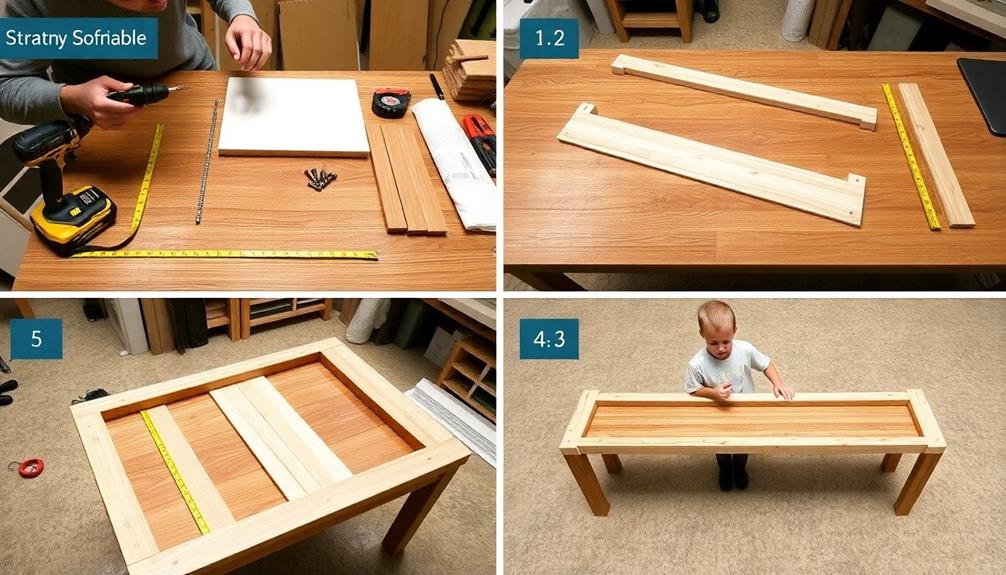
Assembling your sofa table requires careful attention to detail for a sturdy finish.
In addition to the basic assembly, consider exploring building codes and zoning laws to guarantee your furniture meets any specific requirements for your space.
Follow these assembly steps to guarantee your table has the stability it needs for everyday use.
- Attach the outer legs: Begin by connecting the outer legs to the tabletop using two nails for each leg. Make sure they sit flush against the wood for proper stability.
- Install L brackets: Next, reinforce each leg's structure by installing L brackets on the inside. This will help prevent any wobbling during use.
- Add the center leg: After securing the outer legs, position the center leg close to the middle of the table. Use two nails and two corner brackets to attach it for maximum support.
- Notch the legs: If your table is designed to sit flush against a wall, you'll need to notch the legs to accommodate baseboards. Use an oscillating tool for clean cuts.
Finishing Touches
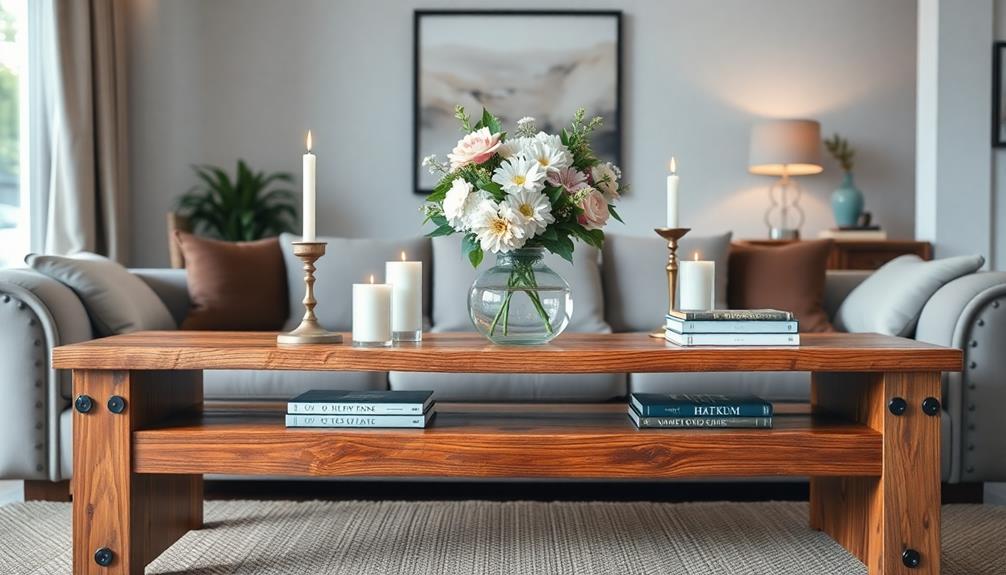
With your sofa table securely assembled, it's time to focus on the finishing touches that will enhance its appearance and durability. Start by sanding all surfaces thoroughly with sandpaper or an orbital sander. This step guarantees a smooth finish and removes any sharp edges or imperfections.
To achieve a high-quality result, it's crucial to take a methodical approach, much like best practices in software quality assurance when verifying product quality. Next, inspect for any visible nail holes or blemishes; fill these with wood filler. Allow it to dry completely before sanding the patched areas for a seamless look.
Now, it's time to apply wood stain. Use a sponge brush or paintbrush to follow the wood grain, letting the stain sit for 10 minutes to an hour. Wipe off the excess to achieve your desired color depth.
Once the stain is dry, finish your table by applying multiple coats of polyurethane. Allow each coat to dry for 6-12 hours—ideally overnight—before adding the next.
Placement Tips
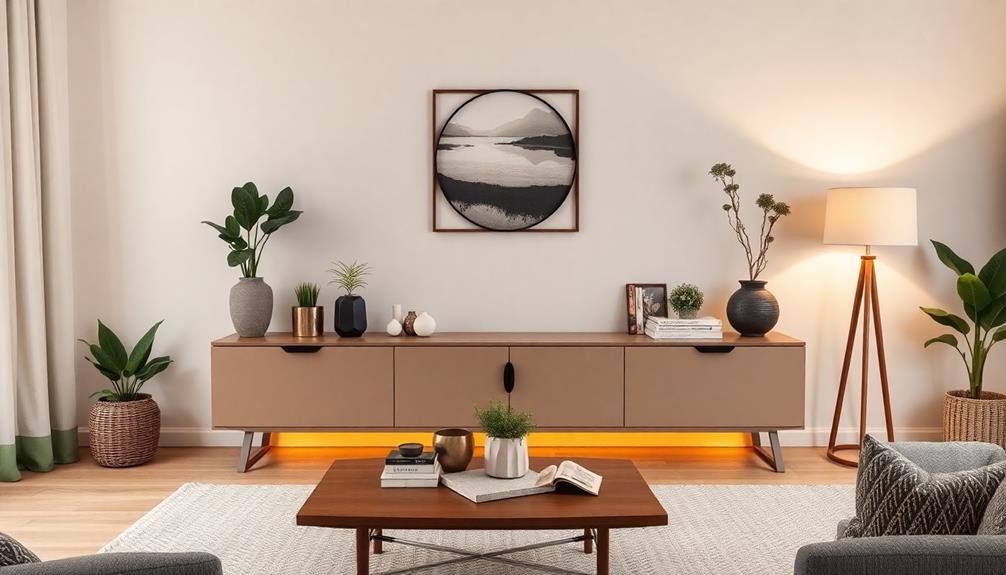
How can you guarantee your sofa table fits seamlessly into your living space? Proper placement is key to blending functionality with aesthetics. Here are some placement tips to help you position your new sofa table perfectly:
- Distance from the Couch: Keep your sofa table about 2-6 inches away from the back of the couch. This allows for easy access while maintaining a cohesive look.
- Stability: For ideal stability, position the table against a wall or wedged between the couch and the wall. This prevents it from tipping over.
- Height Alignment: Match the height of your sofa table to the arms of the couch or make it slightly lower. This creates a visually appealing alignment that enhances your room's overall design.
- Space for Movement: Confirm there's at least 24 inches of clearance around the table for comfortable passage. This makes your living space more functional.
Maintenance Advice
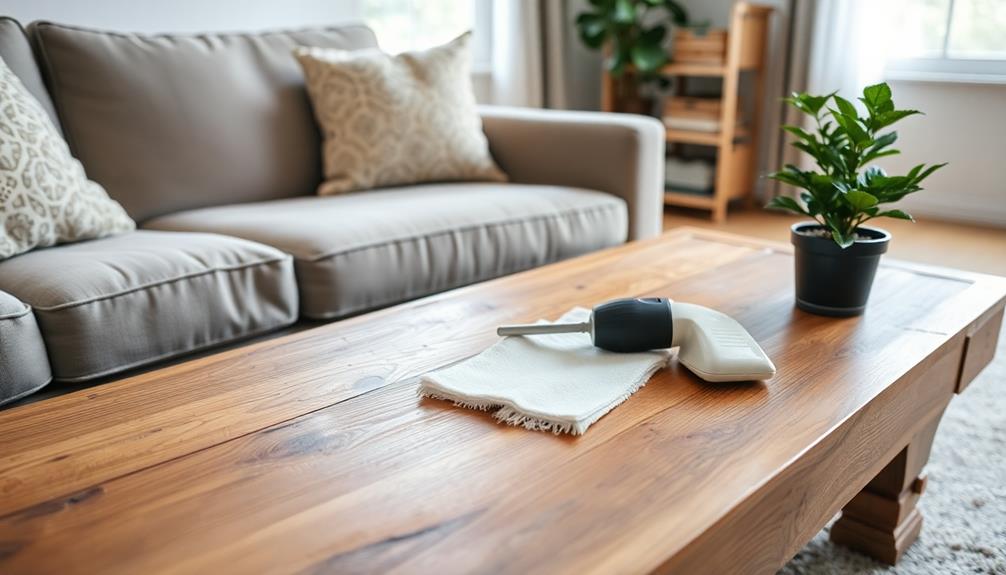
Maintaining your sofa table is essential to keep it looking its best and functioning well in your living space. Regular care prevents damage and prolongs the life of your wood console table. Here are some key maintenance tips to follow:
| Task | Frequency |
|---|---|
| Dusting | Weekly |
| Check screws & brackets | Every 3 months |
| Reapply wood stain/finish | Every 2 years or as needed |
| Use coasters | With every drink/hot item |
| Avoid direct sunlight/moisture | Constantly |
Start by dusting your table weekly with a soft cloth to prevent dirt buildup, which can scratch the surface. Every few months, check and tighten screws and brackets to maintain stability, especially if you place heavy items on it. Reapplying wood stain or finish every couple of years will protect the wood and enhance its look. Always use coasters or placemats for drinks and hot items to avoid moisture rings and heat damage. Ultimately, keep your table away from direct sunlight and extreme moisture to prevent warping or cracking. Following these maintenance steps keeps your sofa table in great shape!
Alternative Uses

A sofa table isn't just a stylish addition to your living room; it can serve multiple practical purposes throughout your home. By thinking outside the box, you can maximize its functionality.
Here are four alternative uses for your sofa table:
- Plant Stand: Transform your sofa table into a stylish plant stand, showcasing indoor plants that thrive in indirect light.
- Entryway Organization: Use it as an entryway organization station. Place baskets or decorative boxes on it to store keys, mail, and other small items for easy access.
- Buffet Table: During gatherings, your sofa table can double as a buffet table, providing ample surface area for serving food and drinks while keeping your dining area uncluttered.
- Charging Station: Consider incorporating power strips or wireless charging mats to utilize the sofa table as a charging station for your electronic devices, adding convenience to your living space.
With these alternative uses, your sofa table can enhance both the aesthetics and functionality of your home, making it a versatile piece that goes beyond a simple decorative display.
Frequently Asked Questions
How Wide Should a Sofa Table Be Behind a Sofa?
A sofa table should generally be 6 to 12 inches narrower than your sofa. Aim for a width of 12 to 18 inches, balancing functionality with aesthetics while ensuring it fits your space comfortably.
What's the Difference Between a Sofa Table and a Console Table?
Think of a sofa table as a graceful dancer behind your couch, while a console table is a versatile performer ready for any stage. Sofa tables are narrower and flatter; console tables offer more storage options.
What Is a Table Behind a Sofa Called?
A table placed behind a sofa is commonly called a sofa table or console table. It serves both decorative and functional purposes, offering extra space for lamps, decor, or storage in your living area.
What Goes on a Sofa Table?
Imagine your sofa table as a stage, showcasing your favorite treasures. You'll place decorative items like lamps, vases, and books, creating a harmonious blend of practicality and style that reflects your unique personality.
Conclusion
Now that you've gathered your materials and followed the steps, you're just a few moves away from revealing your stunning sofa table. Imagine the satisfaction when you place it in your living room, transforming the space with your personal touch. But wait—before you set it down, consider how it'll complement your decor. Will it become a focal point or blend seamlessly in? The choice is yours, and the excitement of the finished piece is just around the corner.
